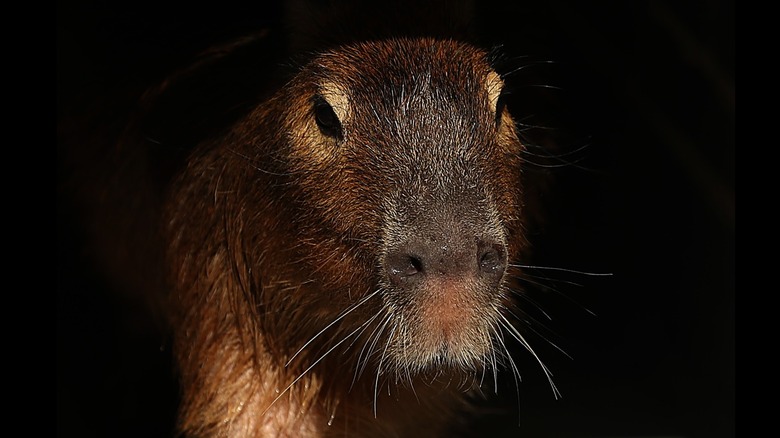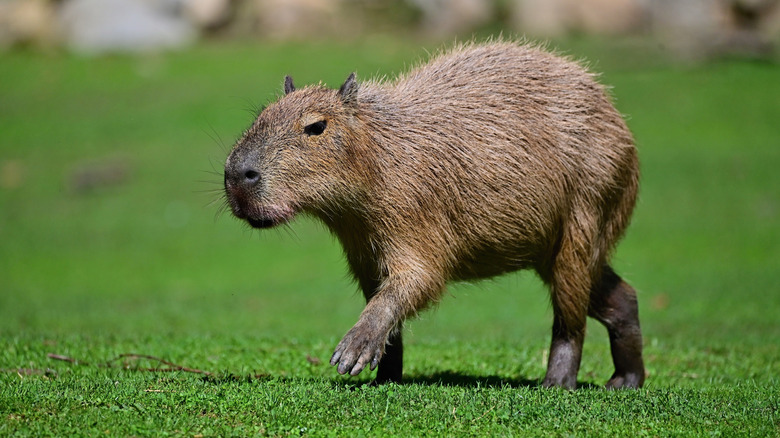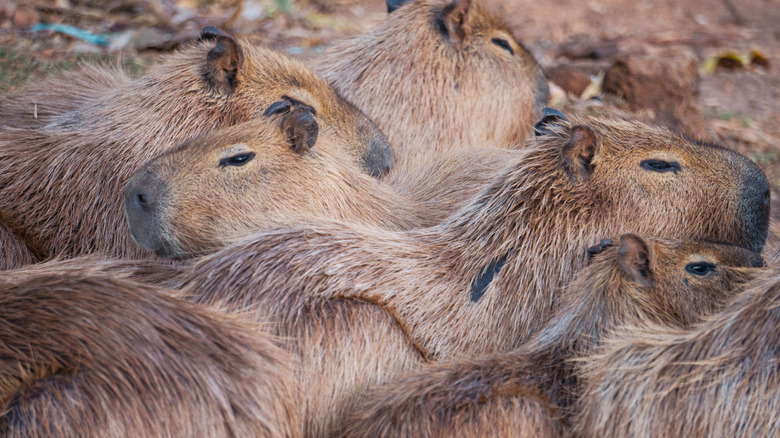The Largest Rodent In The World Actually Eats Its Own Poop
The capybara (Hydrochoerus hydrochaeris) is the largest rodent species in the world, and it's not even a close contest. They range from roughly three to four feet in length, stand up to two feet at the shoulder, and can weigh as much as 174 pounds, making them twice as large as the world's second-biggest rodent species, which is the North American beaver.
Capybaras actually look somewhat similar to beavers, albeit without the signature flat tail, and they even share some of the same adaptations of beavers to accommodate a semi-aquatic lifestyle. With partially-webbed toes and ears positioned high enough to poke above the surface, capybaras spend much of their lives in shallow waters, which provide shelter from predators like jaguars and boa constrictors, and hydrate the capybara's naturally dry skin.
Despite sharing a similar look and affinity for water with beavers, capybaras are most closely related to guinea pigs and rock cavies. They all come from the same continent — South America — where capybaras can be found in forests and wetlands from Panama to northern Argentina.
In recent years, capybaras have become somewhat of a sensation on social media apps like TikTok and Instagram. People have fallen for the animals' adorable habits, like catching hiccups and cuddling with other animals in zoos. However, capybaras have one particular behavior that is anything but adorable. They eat their own poop for breakfast.
A fecal feast
The initial reaction to the thought of poop-eating is an obvious "ewwwwww!" The next reaction is, "why?" and there's actually a very reasonable explanation. It has to do with the rest of the capybara's diet, which is primarily composed of grasses and aquatic plants. These foods contain extremely high amounts of fiber, which makes them naturally difficult to digest, and limits the amount of nutrients the diner can obtain from its meal.
Different types of herbivores have different adaptations to help them get the most out of fibrous foods. A cow's digestive system processes food multiple times in different stomach chambers, but capybaras accomplish this by eating their food twice, once in base form and then through the remains left in poop. Capybaras let their poop sit overnight so that microbes can collect on it and break down the remaining fiber further. In the morning, the capybara has a breakfast that is already semi-digested, allowing them to wring every last obtainable nutrient from it.
The habit of eating poop is called coprophagia, and it's actually pretty common in the animal kingdom. Other rodents do it, including mice, rats, and capybaras' closest relatives, guinea pigs. Coprophagia is particularly prevalent in baby animals, several of which eat their mother's poop in order to develop their gut microbiome. Interestingly, many of these animals are, like the capybara, seen as cute and cuddly, such as pandas and koalas.
Capybaras have come to the U.S. (unfortunately)
Capybaras have recently brought their poop-eating habits to the United States, and as fascinating as we may find these animals, that carries some potentially serious risks. In 1994, a group of capybaras escaped from a conservancy near Gainesville, Florida, in the aftermath of a hurricane. Since then, more and more people have been noticing capybaras in the wild there. A population of at least 50 capybaras was reported in the mid-2010s, and this has likely been compounded by people purchasing capybaras as exotic pets and letting them escape.
Capybaras aren't among Florida's most dangerous invasive species, as no significant impact from their presence has been measured to date. However, the risks of a non-native species in this foreign environment are still significant. Capybaras carry many kinds of pathogens, which they can pass to ticks, which then pass them to humans. Capybaras have even been blamed for outbreaks of spotted fever in Brazil.
Spotting a capybara in the wild isn't likely, but you can identify rodents by their droppings, and the capybara breakfast is pretty easy to spot. They poop in olive-like pellets, which are made slightly less disgusting due to the fact that they aren't as odorous as many other animals' feces, including domestic dogs. You can actually tell whether a capybara's poop is from the first or second digestion. The first droppings are pale in color, but after the capybara eats its poop, it produces a second round of dark brown or black droppings.


